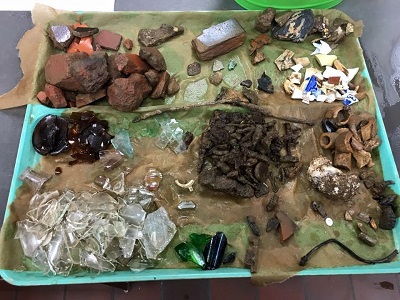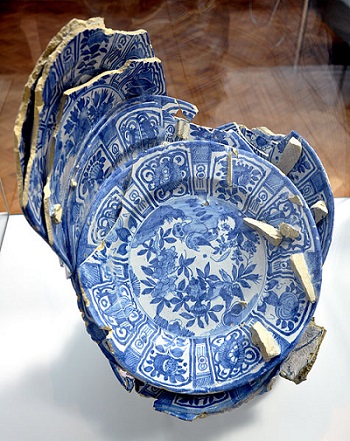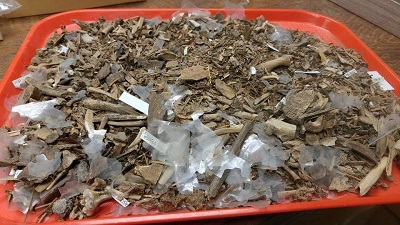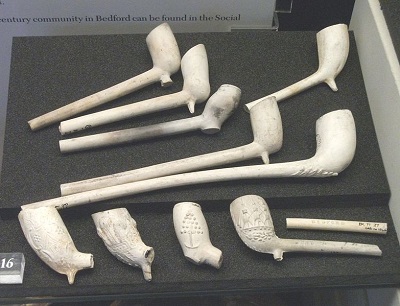The historic buildings listed in this itinerary are not the only remnants left of the past. Material culture can still be found buried beneath the surface. This can be anything that past people left behind. These objects, called artifacts by archeologists, were created, used, lived in, displayed, and experienced. The meaning of the object is just as important as the object itself. For example, many people have trinkets in their homes. These could be small objects that were collected during travel or given as gifts. They could be displayed to serve as a reminder, as thanks, or as a desire to be a part of the mainstream culture. Understanding why certain objects are where they are is important to archeologists. It helps archaeologists reconstruct the past daily life experiences people had. This is why it is so important to not collect objects that are found near historic homes, on protected lands, or any other areas that are a part of our shared heritage. Help us protect the past for the future, by not looting or removing objects from historic sites.
Types of Material Culture

Courtesy of Mia Carey
There are several genral categories of artifacts that can be found on archaeological sites: foodways, personal, household/structural, information, industry/work related, transportation related, natural, and prehistoric/Native American. Knowing which category an object goes into depends on where it was found on the site and what other objects were near it.
Foodways
Foodway related material culture can be anything related to procurement, preparation, service, storage, or actual animal remains. Procurement material culture could be things like fishing hooks or ammunition. Preparation, service, and storage items might be things like cast iron pots or fancy ceramic plates.
Personal
Personal items could include clothing, shoes, medicinal items, decorative items, recreational items, like pipes or children's toys, or cosmetic items like hairbrushes and perfume bottles.
Household/Structural
Household/Strucutral items would be anything used to build and/or furnish the home. This would include items like nails, window glass, door knobs, chamber pots, lamp parts, and coal.
Information
Information related objects might include money, pencils, or inkwells.
Industry/Work
Industry and/or work objects would include things like barbed wire, plows, hammers, gun-parts, needles, or scissors. Related jobs might be something in agricultural, industrial, or domestic work.
Transportation
Transportation related items would include items that are used in motorized, animal-powered, or human-powers transportation. These are items like car parts, horse shoes, harness pieces, bicycle parts, or boat parts.
Native American
Native American objects are anything that Ancient or contemporary Native Americans created and discarded. This could broken pottery or left over materials from stone-tool making.
Natural
Most of the time it is hard for archeologists to figure out what an object is because it does not appear to be related to the objects it was found with. Archeologists used the natural catergory to record plant and animal remains that humans might not have used and discarded. For example, a rabbit might have fallen into a storage cellar and could not escape. After the animal died its remains would have stayed in the cellar. When archeologists find it, they would examine it to see if humans might have eaten it. Without evidence of being used as a meal, archeologists would say that this animal is a natural occurance on the site.
Foodways-Ceramics

Courtesy of Andreas Praefcke
One of the most important things archeologists must do is figure out when a site was occupied. Many times historical records are lost or are inaccurate. Material culture, like ceramics, can help fill in those gaps. Ceramics are typically found in middens, or trash pits. There were no trash pick-up services two or three hundred years ago. People simply dug a hole in their backyards and buried their trash or threw it somewhere out of the way. Middens can contain food remains, glass bottles, toys, or any number of other items. Ceramics in this case are especially important. They are usually the most abundant type of material culture on archeology sites. This is because ceramics are easily broken, do not decay, and cannot be recycled. Ceramics can be dated by the type of material they were made from and by their color and design. Archeologists also look at form, or vessel shape. Ceramic forms are important because they tell archeologists what types of shapes were used. For example, archeologists look at hollowwares versus flatwares. Hollowares are ceramics that have a wide mouth like a tea cup or pitcher. Flatwares are ceramics like plates and saucers.
Foodways- Food Remains

Courtesy of Kristen Walczesky
Archeologists who study food remains are called zooarchaeologists. They receive special training to be able to identify small bits and pieces of bone. Zooarcheologists can tell what type of animal the bone came from, how old the animal was when it died, and how humans prepared the animal. Plantation food remain studies have established that there were socioeconomic differences on the plantation. Archeologists know that slaves received low quality portions of meat, while plantation owners and their families received high quality portions of meat. Low quality meats would be the less desirable parts of the animal:the head, intestines, fat backs, necks, and tripe. Occasionally, slaves were given the heart, kidneys, livers, or ribs. When used in combination with ceramic studies, food remain studies show that slaves were eating more meals like soups and stews. Archeologists know this because there would be a higher portion of bowls than plates. One pot meals were very common for the enslaved. Plantation owners and their families were more likely to eat high quality meats like steaks and roasts-- the portions of the animal with more meat. When used in combination with ceramic studies, food remain studies show that plantation owners were eating foods that required the use of plates rather than bowls. These patterns in food remain studies are found on many plantations including Kingsmill and Flowerdew Hundred. Food remain studies have also shown that typically slaves ate more pork than beef. The remains of chickens have also been found near slave quarters. Though slaves would have eaten the chickens, the chickens were primarily used for their eggs.
At Richneck Plantation,for example, archeologists found that slaves understood the advantages of being familiar with their surroundings. It helped them used the plants and animals that lived in their environment. Archeologists found the remains of wild species such as turtles, opossums, rabbits, squirrels, rats, raccoons, deer, wild birds, fish, and blue crab. This demonstrates that slaves were able to supplement their diets with wild animals and that they had the skills necessary to do so. At any plantation their ability to hunt and fish depended on their access to firearms and ammunition, dogs, traps, etc.
Tobacco Pipes

Courtesy of Simon Speed
One of the most common artifacts found on plantations are tobacco- related artifacts, especially pipes. Tobacco was the first major export from the New World, and has played an important economic role for over 400 years. Tobacco is a part of the American experience. Native Americans used tobacco for religious or spiritual connections. Europeans developed a culture around the social and recreational consumption of tobacco. Enslaved Africans also developed their own smoking rituals and tobacco-related material culture. Archeologists are finding evidence that women smoked tobacco by examining historical records and conducting DNA analysis of pipes. Pipes and other tobacco related artifacts are dateable, and help provide important clues to archeologists working on historical sites.
At Flowerdew Hundred, for example, three distinctive types of tobacco pipes have been found. Native Americans made and used the oldest pipes found on the plantation. Among the Powhatan Confederacy, the primary users of tobacco pipes were adult males of high status. Native American tobacco played an important role in their communities. According to historical accounts, Native Americans offered tobacco to the spirits. Native Americans smoked and exchanged tobacco pipes during rituals. These rituals could welcome strangers and visitors from outside the community. They could also serve to strengthen relationships between members of different tribes. Contemporary Native American tribes continue to use tobacco pipes. Smoking tobacco could take place in ceremonies of reburials, blessings, and community gatherings.
Archeologists also found Chesapeake Pipes at Flowerdew Hundred, and on many other historic sites. These pipes were made from local clays, and range in color from dark grey to orange. They also have distinctive designs. Chesapeake pipes were produced between 1608 and 1700. Archeologists debate about which group of people produced them. In the 1950s, archeologists believed the pipes were made by Native Americans and used by Europeans and enslaved Africans. The designs on the pipes were similar to those made by Native Americans in the Middle Atlantic region. Archeologists in Delaware, Virginia, Maryland, and North Carolina noted the presence of locally made pipes that provided further evidence. By the 1980s, archeologists believed the pipes were produced by enslaved Africans. Archeologists found similarities in the designs of the Chesapeake pipe to the ceramics and other materials produced by West Africans. The production of the Chesapeake pipes also coincided with the arrival of West African slaves. More recent studies of the Chesapeake pipes have reexamined the identity of the people who produced the pipes. Archeologists are now asking what can the pipes reveal about interactions between groups. Archeologists now believe that Chesapeake pipes were the result of interactions between Native Americans, enslaved Africans, and Europeans.
The latest type of pipe that was found at Flowerdew are imported pipes. Imported pipes are found so often on colonial sites that they are compared to the modern cigarette butt. Imported pipes were made in England and Holland and shipped to the New World in the 1600s and 1700s. Archeologists have used imported pipes to date historic archeological sites from the 1600s and 1700s. Imported pipes are dated by the hole in the pipe stem. In the 1600s and 1700s, the shapes of pipes changed in response to fluctuating tobacco prices. The pipe stem became longer. The pipe bowl became bigger, and the diameter of the hole in the stem became smaller. The ability to import pipes also speaks to social status and consumer behavior. Archeologists believe that colonists imported pipes to signal their wealth and status in the society. This would help distinguish them from those who could only afford Chesapeake pipes.
Last updated: September 19, 2016
